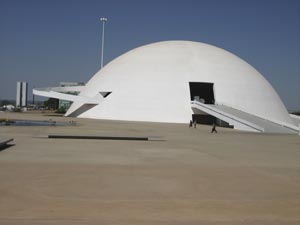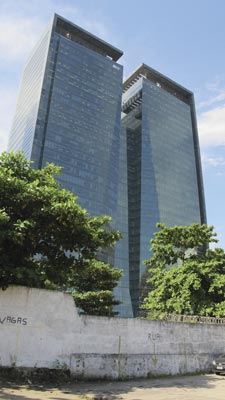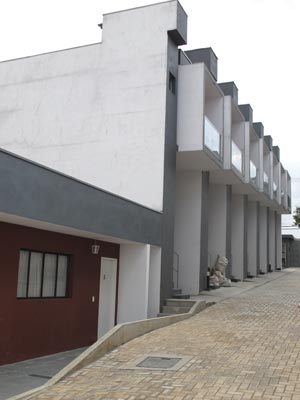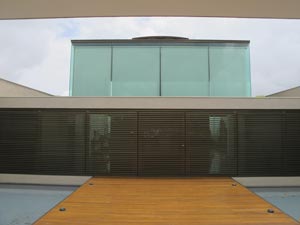The Ghost of the Masters
Approaching almost the end of the first decade of the century, Brazil’s political, social, economic and cultural outcome turns out positive, in spite of the multiple existing contradictions. Since his election in 2003, president Lula dominated the political scene with the fervent flags of socialism raised by the Workers’ Party (PT, Partido dos Trabalhadores), managing a well-balanced stability in the country –partly weathering the world economic crisis– that his fellow Socialists did not reach: Evo Morales in Bolivia, Hugo Chávez in Venezuela or Rafael Correa in Ecuador. The price may have been high, establishing shady deals with the conservative right wing or gulping the corruption of militants from his own party. The contradictory, complex and labyrinthine essence of Brazil’s history makes it difficult to understand and to assimilate the current violent contrasts, factors that attract world interest, as Fernández Galiano recently stated in an interview published in a local magazine. The greater and greater enrichment of financial and bank magnates, of the soya agribusiness’ players and of venal politicians seems unethical with the popular education and health projects, the infrastructural improvements in the favelas, and the Bolsa Familia (Family Allowance) distribution: basic financial aid for the 11 million poor, thus alleviating, with the “Fome Zero” (Zero Hunger) program, traditional famine in the northeastern population.
Being Brazil a “young” people –to paraphrase Darcy Ribeiro-, references to political and cultural inheritance are more oriented towards the veneration of recent mythical figures than towards those from the historical past. Hence the frequent quotes from Getúlio Vargas –who gestated modern Brazil- and from his successor Juscelino Kubitschek, key figure of Brasilia, the new capital. In spite of being fully immersed in the new century’s post-modernity, the cultural patterns of modernity are still valid. At the threshold of the fiftieth anniversary of Brasilia, the debate over its aesthetic and political transcendence is renewed. It is no coincidence that the National Seminar of DOCOMOMO (2009) in Rio de Janeiro is dedicated to the Extraordinary Congress of Art Critics, sponsored by Kubitschek in 1959 to show Brasilia to the world, in which renowned art historians, critics, architects and urban planners participated, such as Bruno Zevi, Giulio Carlo Argan, Richard Neutra, Sigfried Giedion, André Bloc, Gillo Dorfles, among others. And the most surprising fact is that the greatest protagonist of this historic process is still alive: Oscar Niemeyer, who started collaborating with Getúlio Vargas in 1936 in the project of the Ministry of Education and Health; he is about to turn 102 and in persistent creative activity.
 The admiration for his heroic symbolism –just like that of other living stars, as singer Roberto Carlos and writer Paulo Coelho- produced a frenzy of local commissions from governors and mayors all over the country, which brought about a group of recent works in which he repeats formal typologies from the fifties and sixties, without the stroke’s elegance and refinement of his moment of splendid projecting; on the other hand, these can hardly been interpreted and built by his immediate collaborators. The dome of the National Museum Honestino Guimarães in Brasilia (2007) is not comparable to the subtle Oca at Ibirapuera Park in São Paulo. And the group of buildings of the Administrative Center of Minas Gerais (2009) –requested by Aécio Neves, governor of the state– does not constitute either a significant contribution. In spite of multiple works under construction in different regional capitals, he had to face his first public failure, when the project Praça da Soberania (Sovereignty Square) (2009) was rejected by professional associations and institutions. The project was to commemorate the fiftieth anniversary of his Brasilia foundation and consisted in an inclined obelisk, more than one hundred meters high, located at the Monumental Axis and whose presence would affect the unpolluted character of its perspective.
The admiration for his heroic symbolism –just like that of other living stars, as singer Roberto Carlos and writer Paulo Coelho- produced a frenzy of local commissions from governors and mayors all over the country, which brought about a group of recent works in which he repeats formal typologies from the fifties and sixties, without the stroke’s elegance and refinement of his moment of splendid projecting; on the other hand, these can hardly been interpreted and built by his immediate collaborators. The dome of the National Museum Honestino Guimarães in Brasilia (2007) is not comparable to the subtle Oca at Ibirapuera Park in São Paulo. And the group of buildings of the Administrative Center of Minas Gerais (2009) –requested by Aécio Neves, governor of the state– does not constitute either a significant contribution. In spite of multiple works under construction in different regional capitals, he had to face his first public failure, when the project Praça da Soberania (Sovereignty Square) (2009) was rejected by professional associations and institutions. The project was to commemorate the fiftieth anniversary of his Brasilia foundation and consisted in an inclined obelisk, more than one hundred meters high, located at the Monumental Axis and whose presence would affect the unpolluted character of its perspective.
If the national proliferation of Niemeyer’s works created neither talent followers nor a school, Paulo Mendes da Rocha had better luck becoming a national hero after obtaining the Pritzker Prize (2006). In the first place, the formal and spatial codes of the Paulist architect correspond to the strict continuity of the aesthetic principles of the Modern Movement –so dear to the Spanish critics related to Brazil, Helio Piñón and Josep María Montaner-, based on the geometric regularity of forms and the asceticism of the materials. Actually, rather than Brasilia, praised by Max Bense in the sixties, it is Paulo the representative of the “Brazilian Cartesian intelligence”: the garage in Recife (2007); the Museu Escola (Knowledge School Park) in Santo André (2007) and the social housing project in Madrid (2007) are proof of that. And the originality, plastic and constructive quality of his works are largely due to the fact he elaborates projects with talented young people studios, among whom we can quote Angelo Bucci, Fernando de Mello Franco, Milton Braga, Marta Moreira, Eduardo Colonelli, José Armênio de Brito Cruz and Martín Corullon.
The hegemony of both masters, along with other members from the old guard –Ruy Ohtake and João Filgueiras Lima–, does not meet the demand for iconic buildings that local politicians request. If on the one hand, young people find serious difficulties in receiving public commissions due to the limitations imposed by the effective laws –that value more the economic aspect of the work than its aesthetic quality-; and on the other hand, the State lacks conceptual leadership –the one million house plan proposed by Lula is based on the almost childish model of the isolated dwelling with a gabled roof–, then they turned to members of the international jet set. In Porto Alegre, the community support to carry out the Iberê Camargo Museum was unanimous; it was requested to Álvaro Siza (2008). Rio de Janeiro’s mayor, César Maia, wanted to achieve immortality by means of the Cidade da Música (City of Music) by Christian de Portzamparc, an unfinished work that was brought to a halt by his successor Eduardo Paes, citing excessive cost. Nevertheless, he immediately supported the mammoth Museum of Image and Sound in Copacabana, whose contest was won by Diller Scofidio + Renfro (2009). And the government of the state of São Paulo commissioned Herzog & de Meuron the Cultural Complex Luz, São Paulo Companhia de Dança new headquarters, located in the city centre.
 The Landscape’s Mystique
The Landscape’s Mystique
Since its discovery, the Brazilian territory was always assumed as an exotic and sensual space characterized by the exuberance of its tropical vegetation. The prevailing academic tradition, from the colony to the republic, imposed landscaping taken from European models; whose crisis occurred with the aesthetic innovations of modernity created by the talent of Burle Marx from the thirties on. Thus, a Brazilian landscape “school” came up, which favored the presence of green space in the cities, starting from paradigmatic works in Rio de Janeiro and São Paulo: the Aterro do Flamengo (Flamengo Park) and the Ibirapuera Park. In the seventies, the city of Curibita stood out; its controlled planning, under the aegis of mayor Jaime Lerner, established a green line around the urban grid, in which several public affairs were inserted. In recent years, while in Rio de Janeiro speculative interests tried to seize significant fragments of the urban landscape system –the Aterro and the Lagoa Rodrigo de Freitas–, the city of São Paulo settled on multiple initiatives to widen the public space of the metropolis.
On the neighborhood level, the Victor Civita Plaza and Open Museum of Sustainability (2008), by Adriana Levinsky and Julia Dietzsch, turned out to be an original proposal; its wooden deck allows pedestrians to move along the different areas at the plaza, which is situated on a brownfield in the city. On the metropolitan level, in order to reuse an extensive surface area of 240 000 square meters, the previous location of the gigantic penitentiary of Carandiru, a sports-cultural structure was created –Parque da Juventude (Youth Park, 2003-2005)–; its buildings were left in charge of the renowned studio Aflalo e Gasperini Arquitectos, who used a modest language, one without harshness. Landscape architect Rosa Grena Kliass, heiress of the Burle Marx school, designed the green system, characterized by the personality granted to different functional areas –the sports park, the central park and the institutional park–, establishing a dialogue between architecture and some ruins existing in symbiosis with the vegetation. It is worth asserting that her vision of the landscape differs from the pictorial and decorative character that prevailed in the master’s proposals, favoring a system of plastic and volumetric compositions in which nature is conceived as a “builder” of life spaces. Also in São Paulo, a landscape dimension is reached by the design of the surface railway stations –Expresso Tiradentes–, made by Ruy Ohtake (2007), and identified by the intense range of colors of its elements. And we cannot leave out the appreciation of nature at the Inhotim Contemporary Art Centre in Brumadinho, Minas Gerais –by Rodrigo Cerviño López–, formed by a group of exhibition spaces of cubic shapes distributed along the extensive bucolic surroundings.
Peripheral Cosmopolitanism
 Local architecture criticism persists in the search of an identifier of “Brazilianity” in its regionalist, Paulist and Carioca versions, in which the purist image of the “beautiful creature” thought up by Lina Bo Bardi in the fifties passed away. Now, in this new century, the dialogue with the globalized world gestated a “hybrid” language –to remember Iñaki Ábalos–, in which not only fragments of different origins –cultured and popular– get mixed up, but also the frontiers among architecture, design and plastic arts are dissolved. In terms of cultural representation of Brazil worldwide, the irreverence and aesthetics of the unexpected contrast in the work of visual artist Vik Muniz; the heterodox designs of brothers Fernando and Humberto Campana; and the absorption of the popular culture by the scenographer Gringo Cardia are all manifestations of it. Along those lines is the production of some anti-establishment young people studios such as zerOgroup in Manaus –Lilian Kiesslich Fraiji and Laurent Troost–; Vazio in Belo Horizonte –Carlos M. Teixeira–; and Triptyque in São Paulo –Greg Bousquet, Carolina Bueno, Olivier Raffaelli, and Guillaume Sibaud.
Local architecture criticism persists in the search of an identifier of “Brazilianity” in its regionalist, Paulist and Carioca versions, in which the purist image of the “beautiful creature” thought up by Lina Bo Bardi in the fifties passed away. Now, in this new century, the dialogue with the globalized world gestated a “hybrid” language –to remember Iñaki Ábalos–, in which not only fragments of different origins –cultured and popular– get mixed up, but also the frontiers among architecture, design and plastic arts are dissolved. In terms of cultural representation of Brazil worldwide, the irreverence and aesthetics of the unexpected contrast in the work of visual artist Vik Muniz; the heterodox designs of brothers Fernando and Humberto Campana; and the absorption of the popular culture by the scenographer Gringo Cardia are all manifestations of it. Along those lines is the production of some anti-establishment young people studios such as zerOgroup in Manaus –Lilian Kiesslich Fraiji and Laurent Troost–; Vazio in Belo Horizonte –Carlos M. Teixeira–; and Triptyque in São Paulo –Greg Bousquet, Carolina Bueno, Olivier Raffaelli, and Guillaume Sibaud.
In the first place, they are characterized by the anxiety to be part of the international architectural dynamic, in response to the growing invasion of foreign studios in Brazil: Kohn Pedersen Fox (KPF), Davids Brody Bond, Hellmuth, Obata & Kassabaum (HOK), Bob Stern, Philippe Starck, among others, arrived in association with local architects. The young professionals were acknowledged in different contests: Carlos M. Teixeira was awarded the third prize in the Tangshan Memorial Park competition in China (2007); and Triptyque was also invited there to participate in the Hong Kong & Shanghai Bi-City Biennale (2009); and ZerOgroup was awarded in the contest for the tourist resort in Split, Croatia (2008) and at the Bering Strait Project Competition in United States-Russia (2009). Hence the unheard-of and original nature of the Triptyque projects: the X pilotis and volumetric joints of the Fidalga apartment building; the ecological green facades of the office building Harmonia; and the thin and curvy luminous wooden filters of the publicity agency Loducca, all examples located in São Paulo.
An Aesthetic Ego
In spite of the significant private and public works by the great studios of the second Paulist generation –Aflalo e Gasperini, Botti & Rubin, Carlos Bratke, Roberto Loeb, Paulo Bruna, Decio Tozzi, Königsberger & Vannucchi, João Walter Toscano–, the theme of the individual dwelling, which undoubtedly facilitates the development of architectural experimentation, contradictorily turns out to be the most representative subject matter in the Brazilian youth production. On the one hand, there is a canonical core defined by the continuity in the Brutalist inheritance of masters João Vilanova Artigas and Paulo Mendes da Rocha, although now in a minimalist tone. There are the residences designed by Angelo Bucci and Alvaro Puntoni, the studios MMBB and UNA; with its branch in Belo Horizonte, in the work by Gustavo Penna. Within the asceticism imposed by the limitations on materials and the persistency of the Cartesian composition system, we find the experimental paths trodden by Andrade and Morettin; Lua and Pedro Nitsche in São Paulo; and the Carioca rara avis, Carla Juaçaba. They are characterized by the pursuit of continuity and integrity in interior spaces, the use of industrialized materials in the structure, coverings and interior divisions, the presence of vernacular elements –bamboo, woven fiber panels, local wood– and the relation with the landscape. Carla Juaçaba elaborated a subtle interpretation of the Miesian structural inheritance, fused together with the rusticity of the natural environment, in both the Rio Bonito and the Varanda houses, located in the state of Rio de Janeiro.
 However, without question, the main protagonists of the current Brazilian architecture are Isay Weinfeld and Marcio Kogan, little appreciated by local critics –still immersed in the “modernist” unpolluted core–, and accepted in their true value at international levels: Isay recently received the Future Projects Award granted by the English magazine Architectural Review, for the department Building 360º project; and Kogan, in two occasions (2004 and 2005), the Record Houses Award by the North American magazine Architectural Record. It is impossible to review the multiple and distinct houses designed by both of them, among which outstand those made by Isay at Guarujá beach, São Paulo: Tujucopava (1998) and Iporanga (2006). In both of them, the persistent whiteness stands out over the ocean blue and the surrounding forest greenness. In the former, a nautical climate was created; while in the latter, the wooden frameworks that identify the second floor for the bedrooms represent the adaptation to the tropical climate.
However, without question, the main protagonists of the current Brazilian architecture are Isay Weinfeld and Marcio Kogan, little appreciated by local critics –still immersed in the “modernist” unpolluted core–, and accepted in their true value at international levels: Isay recently received the Future Projects Award granted by the English magazine Architectural Review, for the department Building 360º project; and Kogan, in two occasions (2004 and 2005), the Record Houses Award by the North American magazine Architectural Record. It is impossible to review the multiple and distinct houses designed by both of them, among which outstand those made by Isay at Guarujá beach, São Paulo: Tujucopava (1998) and Iporanga (2006). In both of them, the persistent whiteness stands out over the ocean blue and the surrounding forest greenness. In the former, a nautical climate was created; while in the latter, the wooden frameworks that identify the second floor for the bedrooms represent the adaptation to the tropical climate.
Although these two examples are particularly ascetic, in most of their architecture, Weinfeld and Kogan –who worked together in some projects–, favor the formal and spatial contrasts defined by the use of unheard-of and antagonistic materials, the dialogue between natural and artificial illumination, the use of metaphors associated to the users culture, as well as the integration of graphic and pictorial elements taken from their experiences in the making of scenographies, films and theater plays. Thus, architecture is no more an isolated specialized field of action, but, defined in terms of classical art, the expression of the arts’ synthesis, understanding now the totality of the artistic and technological universe of postmodern society.
Rio de Janeiro, August 2009- June 2012.
[Expanded version of the text published in AV Monografías 138 (2009), Madrid, with the title: Brasil, las ideas en el laberinto (Brazil, Ideas in the Labyrinth)]
Related Publications

How Harumi Yamaguchi invented the modern woman in Japan
March 16, 2022












